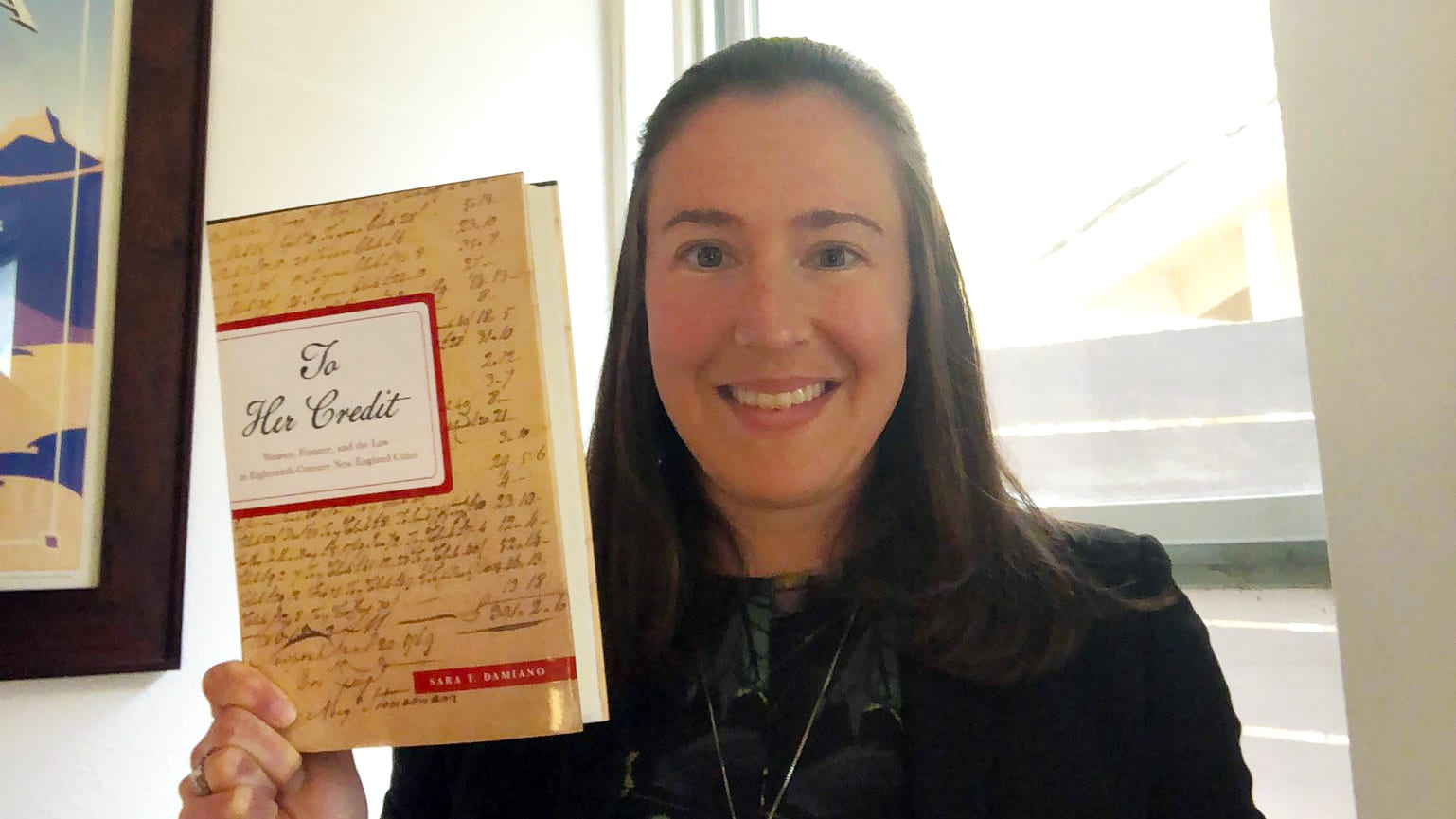
We took a minute to catch up with Dr. Sara Damiano on her new book, To Her Credit: Women, Finance, and the Law in Eighteenth-Century New England (Johns Hopkins University Press). Dr. Damiano’s book “uncovers free women’s centrality to the interrelated worlds of eighteenth-century finance and law. Focusing on everyday life in Boston, Massachusetts, and Newport, Rhode Island—two of the busiest port cities of this period—Damiano argues that colonial women’s skilled labor actively facilitated the growth of Atlantic ports and their legal systems. Mining vast troves of court records, Damiano reveals that married and unmarried women of all social classes forged new paths through the complexities of credit and debt, stabilizing credit networks amid demographic and economic turmoil. In turn, urban women mobilized sophisticated skills and strategies as borrowers, lenders, litigants, and witnesses.”
Congratulations! How does it feel to have your first book published?
Dr. Damiano: It feels great! I began using court records to study eighteenth-century women when I was an undergraduate, and continued that work for my PhD dissertation—so this book is the culmination of a very long process. I’m excited that my research can now more readily shape scholarly conversations about women’s relationship to economic and legal development in early British North America.
What is the general argument of your book and how do you see is speaking to other works in your field?
Dr. Damiano: To Her Credit argues that free white women’s financial and legal work was essential to economic and legal development in eighteenth-century New England. I focus on the region’s two largest port cities, Boston, MA and Newport, RI. In these place, men’s work often took them to sea, sometimes never to return, and women outnumbered men. Everyday practices therefore demanded that women become skilled users of credit and debt.
My work sits at the intersection of several subfields, including women’s and gender history, legal history, and the history of capitalism. By reconstructing everyday practices, we can more fully recognize women’s contributions eighteenth century financial networks and legal institutions. We can also see that specific roles—such as creditor, debtor, or witness—endowed women with situational forms of authority or vulnerability that broad frameworks like patriarchy and marriage law can obscure.
Can you tell our readers a bit about your research process, and the trajectory of the project more generally?
Dr. Damiano: While my research uses many different kinds of manuscript and printed sources, I relied most heavily on county court records. In the absence of modern financial institutions like banks and collection agencies, the courts were a very important arena in which New Englanders enforced financial obligations. Of the hundreds of cases heard at each court term, more than 80 percent concerned debts. In other words, unlike today, going to court was a commonplace, routine activity. I used court records in three ways. First, I examined records from thousands of cases in order to quantify and compare women’s and men’s activities. Second, I reconstructed stories of individual women who waged extended legal battles. Third, I aggregated small details from routine cases in order to create a composite picture of women’s everyday practices. I wrote more about this third method in a recent blog post for JHU Press.
Is there a particular vignette that sticks out to you that you’d like to share from your book?
Dr. Damiano: As New England’s legal system developed during the eighteenth century, courts and laws increasingly favored creditors over debtors. As I explain in my book, this benefitted many women. White urban women were important lenders within their communities. Two-thirds of female litigants in debt suits were plaintiffs and creditors, and they overwhelmingly won their cases.
But, this same system disadvantaged female debtors, especially those who made legal errors or were saddled with extensive debt. One of these woman was Ann Maylem, the Newport, Rhode Island widow of an insolvent rum distiller. She spent six years battling her late husband’s former business partners, and took her cases to Rhode Island’s highest courts. In the course of her efforts, she also took the rare step of publishing a broadside (an eighteenth-century poster) outlining her side of the case. Her story contains elements of both persistence and tragedy. Read Chapter 5 of my book to learn more!
Where do you hope future projects will take you?
Dr. Damiano: I remain fascinated by eighteenth-century court records and the ways in which they provide windows onto the lives of marginalized individuals, especially women. In the course of researching To Her Credit, I’ve become interested with urban residents’ interactions with minor law enforcement officials—figures including sheriffs, constables, jailkeepers, and watchmen. For my next project, I’m planning on investigating the power dynamics at play during such interactions, and the skills that free and enslaved men and women used to protect their persons and property.
